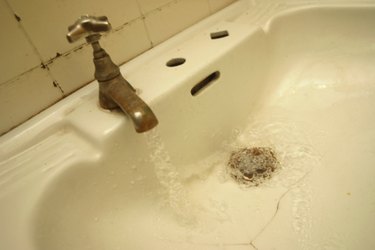Things You'll Need
Rubber gloves
Cup
Rags
Bucket
Tweezers or needle-nosed pliers
Wire
Duct tape
Petroleum jelly
Plunger
Pipe wrench
Plumbing snake

There is nothing worse than a clogged sink drain, especially if you are in the middle of washing dishes or your hair. Drains become clogged when hair, food, grease and other debris is tossed in but does not go fully through the drain and out to the sewer main. It is possible to clear out a clogged sink drain on your own without the use of chemicals. Over time, chemicals can hurt your pipes and cause a bigger expense.
Step 1
Put on rubber gloves and remove as much water from the area as possible by dipping it out with a cup. Soak up the rest of the water with an absorbent rag and squeeze the water into a bucket. Repeat until most of the water is gone.
Video of the Day
Step 2
Inspect the cross hairs in the drain. Remove any hair or other debris that may be caught there. This can be cleared away by using tweezers or needle-nosed pliers.
Step 3
Insert a long piece of wire, with a hook bent at one end, into the drain. Pull out the debris with this and toss the debris into the trash.
Step 4
Cover up the air holes in the sink. Either enlist a friend to hold a wet wash cloth over the drainage holes or cover them with a piece of duct tape.
Step 5
Apply a thin layer of petroleum jelly over the bottom lip of a plunger. This gives you a tighter seal over the drain hole.
Step 6
Place the lip of the plunger so it completely covers the drain hole.
Step 7
Fill the sink with hot water until it covers the rubber part of the plunger.
Step 8
Thrust the plunger up and down in a quick motion for about two minutes.
Step 9
Remove the plunger to test the drain. If the water does not flow out, remove the water and proceed to the next step.
Step 10
Place a bucket under the P-trap.
Step 11
Remove the nuts that hold the P-trap in place with a pipe wrench. Place a rag between the teeth of the pipe wrench and your pipe to keep from scratching the finish.
Step 12
Clean out the P-trap by flushing it out with clean running water.
Step 13
Install the P-trap back in place with a pipe wrench. Use a rag as directed in step 11.
Step 14
Run hot water into the sink to test if the water drains away and to check for leaks. If this does not solve the problem, proceed to the next step.
Step 15
Remove the P-trap again and insert the head of a plumbing snake, or auger, into the drain. After the head is in the drain about 3 inches, turn the handle in a clockwise direction until it meets resistance.
Step 16
Reverse the direction of the auger by turning the handle in a counterclockwise direction 1 or 2 inches.
Step 17
Repeat the forward, backward motion of the auger until the drain is clear.
Step 18
Pull the auger out, wiping the cable with a rag to keep the mess minimal. The auger head will come out with most of the gunk, so have your bucket underneath to catch it.
Step 19
Replace the P-trap and turn on the hot water. Allow the water to run for 10 minutes to clear out the drain.
Video of the Day